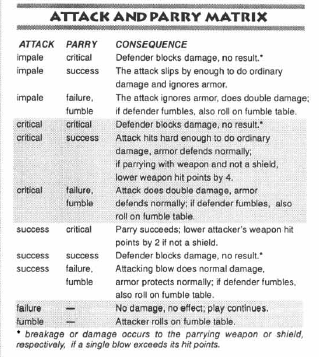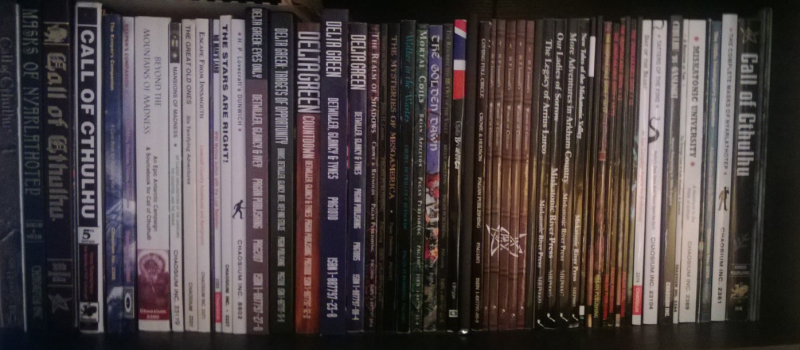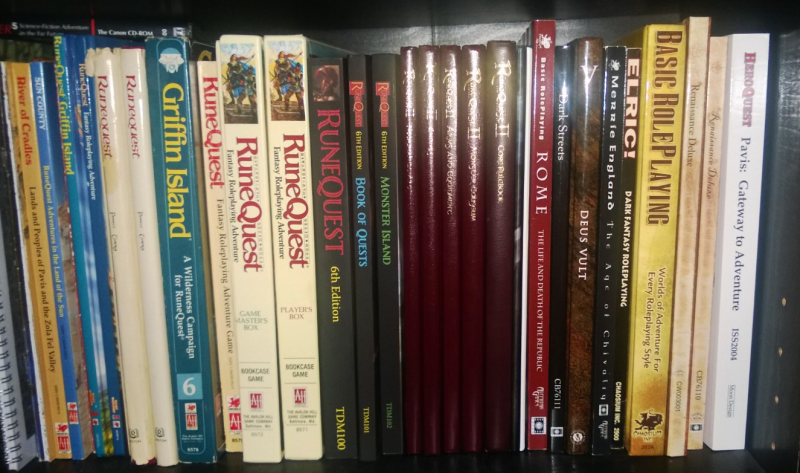-
Posts
319 -
Joined
-
Last visited
-
Days Won
3
Content Type
Forums
Blogs
Gallery
Downloads
Profiles
Events
Posts posted by K Peterson
-
-
But...you really should be careful mixing and matching stuff, especially without the players be up on it and able to playtest stuff. There tend to be unforeseen complications that arise from swapping out rule sections. One thing that MRQ proved was that the rules in RQ/BRP are interconnected and changing any one thing can have a domino effect.
Interesting. I haven't encountered any problems mixing and matching d100 rules sets in the past. At least nothing that has caused a noticeable effect on gameplay. On the contrary, d100/BRP has proven to be pretty resilient to whatever goofy changes I've made to it.
Could you provide an example of how MRQ caused a domino effect of complications?
P.S. As one example, I'm considering swapping out Elric's Major Wound Table with the Major Wound system found in Renaissance. There are similarities but in Renaissance the results are broken up into rough hit locations, allowing for PCs to aim at, and damage locations when taking a penalty to their attack roll. It doesn't go so far as introduce RQ-like hit location tracking, but some more focused targeting, if player's are willing to accept the penalty (and still do enough damage to cause a Major Wound). I could see the penalty as something to consider in the case of Elric's general skill levels, but I'm not sure if a complication will result from this change.
-
When I run a d100 campaign, I tend to do a lot of system customization work during my prep-time. I usually use one product as a core framework and then replace parts with rules from other d100 products - cherry-picking my favorite d100 rules, basically. For example: a few years ago, I ran a Horror-Western campaign that used MRQ2 as a framework, and then imported rules from Call of Cthulhu, and various d100 sourcebooks. I've had very few campaigns where I've used a d100 game as-written - probably CoC 5+ years ago.
What I'm not good with, however, is organizing these house rules (/major system tweaks) into an accessible format. I've either had a rule-book handy during play, and scads of random documents with house rules. Or I've edited an existing pdf, and merged it with other pdfs. Inevitably, I get a player asking me where to look to get a better view of the final 'product'. And, I typically answer, "Well, it's here... and here... and here." Usually, these players just give up eventually and hit me up with rules questions during the sessions.
I'm making some plans now to put together a Sword & Sorcery sandbox campaign, and I want a better way of compiling and 'presenting' the chopped-up rules to make it easier for players to reference. In this case, I'm going to be using Elric! as a framework and replacing parts with pieces from OpenQuest 2e, and Renaissance. I've consider either:
- Compiling a number of pdfs broken into sections for chargen, task resolution, combat, etc.
- Or, maybe going whole-hog and copy-pasting the contents into a doc, editing it and formatting into a 'book', creating a 'private' publishing through Lulu, and ordering a few copies.
Any BRP GMs that use any specific methods to organize their house rules, or BRP mishmashes?
- Compiling a number of pdfs broken into sections for chargen, task resolution, combat, etc.
-
I saw a copy of Worlds of Wonder listed on eBay 2 weeks ago. Went for $27 - nearly half of which was the shipping charge.
I 'watched' the auction, but never really found the temptation to throw some cash at it.
-
Sure, I understand that. It's not a rules set that I'm familiar with, but I know of its existence.
I made the assumption that since he included the phrase, "Those other options are sooo '80s", that he was referring to the recent Magic World not the Worlds of Wonder boxed set. There's also a lot more recent 'talk' on this forum about the new Magic World vs. the old.
-
For the most part, I've used RQ for other settings - my own homebrewed worlds, or settings like The World of Xoth (as presented in The Spider God's Bride). It's been a long time since I've used it for Glorantha. If I did run a Glorantha campaign, I'd likely use RQ2. (And even then, it wouldn't be a canonical Glorantha - more an interpretation).
I find Option 4 - Magic World, yaddayadda - to be a little strange. Considering MW is a retread of RQ3 (80's) and Elric! (early 90s, but with parts that originated in the 80's, as well). There's nothing about the mechanics of MW that strikes me as shiny and (more) modern. The cover art would qualify - but a lot of the interior art is recycled from 80's sources.
-
Anything ever happen with this?
-
I've been reading through this oldie-but-goodie recently. Owned it for many years, but have never played it. Last looked at it about 10 years ago and then filed it away in a dark corner of my bookcase to be forgotten.
Now, it's interesting comparing the mechanics of Elric! with the d100 gaming I've been running over the past 5 years. Which has mostly been MRQ2, and permutations of that system. It's tough not to be a bit cynical now after having played a system that used attribute-derived starting skill levels rather than one with base starting skill levels. Or used improvement points rather than skill checks. Or combat styles instead of weapon classes.
But, still.. there's quite a bit I do like about Elric!: total hit points and the major wound table, rather than hit locations; the elemental and demon summoning rules; and the more abstracted combat rules. I'd really like to perform major surgery on both MRQ2 and Elric! to Frankenstein-together a general Sword & Sorcery rules set.
-
RQ6 has falling damage at d6 (to one hit location) for 2-5m fallen. And then increases significantly at greater heights.
-
I've never had players request CoC pregens before... but if I did, I'd probably use something like the CoC Character Generator App or Byakhee to do some of the work for me.
-
I ran it with 4 players back around 2004/2005. It went fairly well. Though, the campaign ended in Cairo when 2 of the investigators were eaten by ghouls, 1 went permanently insane, and the last spent a good amount of time in a sanitarium before returning to a different campaign 4 years later. The Bent Pyramid was a really tough ride for them, but I still consider the campaign a success.

I also ran it with 5 players in 2012. No real problems, though the campaign ended early due to some scheduling conflicts. No dead investigators throughout the New York and London chapters. One weak-willed PC did suffer some serious hits to his Sanity over that time.
-
-
I was looking through Renaissance Deluxe last night, re-reading the combat chapter. And something stood out to me since the last time I'd read it - something I hadn't remembered. When an attacker achieves a critical hit, there is no advantage whether a defender successfully, or unsuccessfully reacts to it. Same result: Attacker does maximum damage and ignores defender's armour. If you don't Crit Parry/Dodge you're screwed. And, even if you do, you're still getting hit.
This struck me as odd. Is this an OpenQuest-ism? Seems a bit cruel.

-
Is it possible to purchase a membership to the OpenQuestrpg.com "members area" after the fact? For those that didn't participate in the IndieGogo campaign, or weren't aware of it?
-
Personally, I'm a believer in playing a system (relatively) as-is before making serious changes to it. And not necessarily trusting to public opinion until I have played it for myself and see whether my experience matches up to that opinion, or is different.
Another factor is: once RQ2 PCs get high enough skill levels they are serious movers-and-shakers in the world. And, as such, should face challenges that test them. Which could include facing NPCs with high Defense and potent spells.
P.S. I couldn't see myself adding a Dodge skill, due to the existence of the abstract Defense value.
-
I don't like the bonus/penalty die (this feels more like Savage Worlds than CoC), and I don't like the pushing dice option.
To me, the bonus/penalty die seems a lot like the advantage/disadvantage mechanic introduced in D&D Next. But, I'm not that familiar with Savage Worlds.
-
-
Any reviews out there for OpenQuest 2? I'm curious what rules improvements/changes have occurred to the system rather than artwork/editing/layout.
-
Other projects in the pipeline include a world-spanning campaign for Dark Streets, our grim 18th century Cthulhu Mythos setting
<Applause>
-
I'm not optimistic from what I've seen so far. I can't see myself making use of percentile stats, pushing Luck, the bonus/penalty die mechanic, or Build.
I'd hoped for more of a tightening of the core system, using examples and inspiration from recent d100 products (like MRQ2/RQ6/OpenQuest). Building upon BRP/d100's lineage, rather than borrowing from D&D Next - or whatever outside sources - to make CoC more "modern".
-
I'm a little late to the party, having stumbled upon Dark Streets this month while I was looking through Cubicle 7's online store. I grabbed the pdf off of DTRPG, and have been really impressed with DS' historical setting, and the tweaks to the Renaissance system. Impressed enough to track down a print copy - that took some work.
Anyway, nice work, Cakebread & Walton. I'm going to have to pay closer attention to your future releases.
-
FASA Star Trek.
-
I've had the same trouble. Tried a couple times to access their site over this afternoon.
-
Oh, I won't disagree with you there; 10AP seems excessive to me. Do they have some form of armoring enchantment that makes up the difference in AP from plate armor? Or, is it supposed to be exceptionally-well-crafted?
If the Knights of the North are an uber-competent group, I would treat them as a very exclusive cult that had high requirements for membership. Something along the lines of Runelord/Runepriest in Runequest. High skill levels in a number of skills, a serious time sink obligation, heavy tithing, etc. Joe Average wouldn't be able to walk in off the street, join their cult, and get a fancy suit of armor off the rack. They would already need to be a highly-skilled, well-reknowned individual.
And, in my opinion, if someone joined such a prestigious cult, it would be close to an "end-game" for that character. They'd be devoting so much time to the organization - and will have so many responsibilities - that they wouldn't have the time to go adventuring.
-
A couple options:
Magic: Speedart or Firearrow
Roll a critical. From what I read in the OpenQuest dev kit, "critical hits also ignore armour"






Customizing and Compiling
in Basic Roleplaying
Posted
Did this occur with the original Mongoose RuneQuest ("MRQ1")? Or, the later version (MRQ2), as well?
I'm not very familiar with their first attempt at RuneQuest. I remember buying it in 2008 or 2009, and then quickly getting rid off it. Seemed a sloppy mess with poor artwork.
Renaissance uses a flat armor value for the entire body. Similar to Elric!. Though, of course, Elric! used a random armor value (roll a die type depending on the type of armor worn, with modifiers whether you wore a helm or not). I don't have any problems with random armor value, as-is.